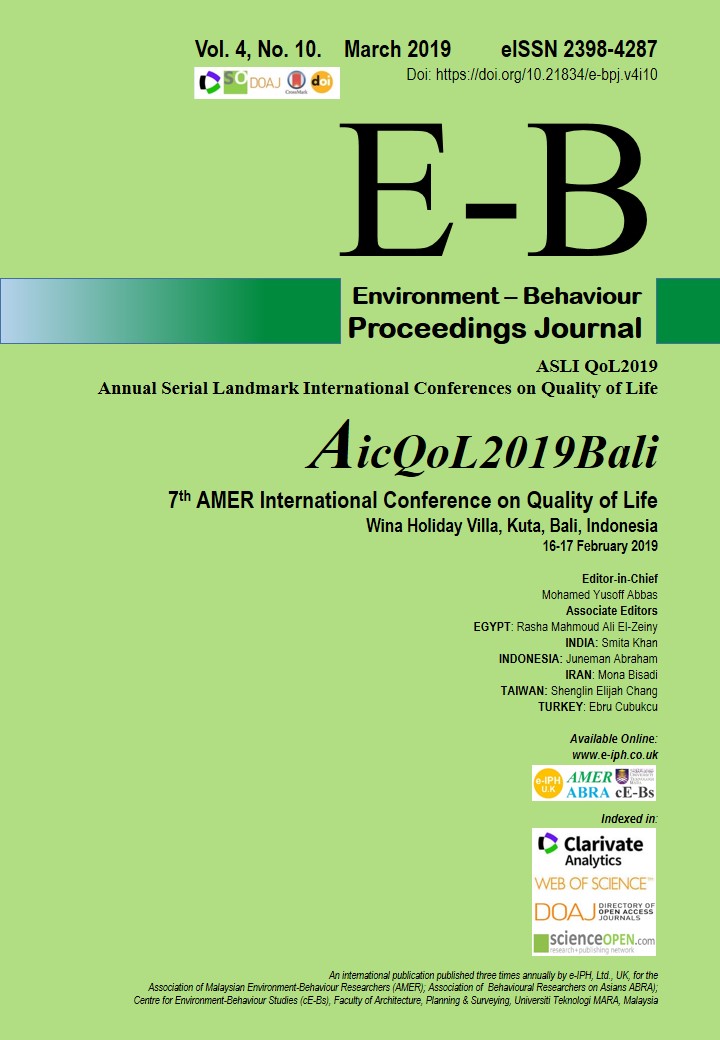Human Interaction In Urban Open Spaces
DOI:
https://doi.org/10.21834/e-bpj.v4i10.1590Abstract

The aim of this paper is to evaluate the multi-dimensional human interaction experienced in the open spaces and develop the ranking of human interaction in relation to the typological of open spaces. The analysis in this paper addresses human-human interaction and human-nature interaction in five selected open spaces of Shah Alam, Selangor, Malaysia. The findings show that all four research domains namely socio-demographic domain, the human-human interactions in open spaces domain, the human-nature interactions in open spaces domain and perceived benefits domain significantly influence the human interactions in the Shah Alam open spaces area.
Keywords: open spaces; sustainability; human interaction; landscape
eISSN: 2398-4287 © 2019. The Authors. Published for AMER ABRA cE-Bs by e-International Publishing House, Ltd., UK. This is an open access article under the CC BYNC-ND license (http://creativecommons.org/licenses/by-nc-nd/4.0/). Peer–review under responsibility of AMER (Association of Malaysian Environment-Behaviour Researchers), ABRA (Association of Behavioural Researchers on Asians) and cE-Bs (Centre for Environment-Behaviour Studies), Faculty of Architecture, Planning & Surveying, Universiti Teknologi MARA, Malaysia.
DOI: https://doi.org/10.21834/e-bpj.v4i10.1590
References
Abu-Ghazzeh, T.M., (1996). Reclaiming public space: the ecology of neighborhood open spaces in the town of Abu-Nuseir, Jordan. Landscape Urban Plan.36, 197–216.
Agency, C. I. D. (2012). Indicators for Sustainability: How Cities are Monitoring and Evaluating Their Success (84). Canada.
Ali, S. M., & Nawawi, A. H. (2006). Factors That Influence User’s Satisfaction on Urban Park: Comparison Between KLCC Park and Subang Recreational Park. Universiti Teknologi Mara.
Chiesura, A. (2004). The role of urban parks for the sustainable city. Landscape and Urban Planning, 68(1), 129–138. doi:10.1016/j.landurbplan.2003.08.003
Department of Town and Country Planning of Peninsular Malaysia (2013). Planning guidelines of open spaces and recreation areas. Ministry of Housing and Local Government.
Gobster, P.H., (2001). Visions of nature: conflict and compatibility in urban park restoration. Landscape Urban Plan. 56, 35–51.
Illia, F., Omar, D., & Hanita, N. (2013). Human Interaction in Open Spaces, (December), 17–18.
Illia, F., Omar, D., & Hanita, N. (2014). Theoretical Review on Sustainable City Indicators in Malaysia, 04.
Jim, C.Y., Chen, W.Y., (2006a). Recreation-amenity use and contingent valuation of urban greenspaces in Guangzhou. China. Landscape Urban Plan. 75, 81–96.
Jim, C.Y., Chen, W.Y., (2006b). Impacts of urban environmental elements on residential housing prices in Guangzhou (China). Landscape Urban Plan. 78, 422–434.
Mamaghani, N. K., Asadollahi, A. P., & Mortezaei, S.-R. (2015). Designing for Improving Social Relationship with Interaction Design Approach. Procedia - Social and Behavioral Sciences, 201(February), 377–385. https://doi.org/10.1016/j.sbspro.2015.08.190
Mansor, M., Said, I., & Mohamad, I. (2010). Experintal Contacts with Green Infrastructure's Diversity and Well Being of Urban Community. Asian Journal of Environment-Behaviour Studies, 31-47
Marzukhi, M. A., Karim, H. A., & Latfi, M. F. (2012). Evaluating the Shah Alam City Council Policy and Guidelines on the Hierarchy of Neighborhood Open Space. Procedia - Social and Behavioral Sciences, 36(June 2011), 456–465. doi:10.1016/j.sbspro.2012.03.050
Marzukhi, M. A., Omar, D., Oliver, L. H. L., Hamir, M. S., & Barghchi, M. (2011). Malaysian Urban Indicators Network : A Sustainable Development Initiative in Malaysia, 25(1), 77–84.
Matsuoka, R. H. (2008). High school landscapes and student performance, 121
Matsuoka, R. H., & Kaplan, R. (2008). People needs in the urban landscape : Analysis of Landscape And Urban Planning contributions, 84, 7–19. doi:10.1016/j.landurbplan.2007.09.009
Omar, D., Illia, F., & Hanita, N. (2015). Human Interaction in Open Spaces, 01, 1–9.
Philips, L.E., (1996). Parks: design and management,United States of America: McGrawHill.
Saleh, M.A.E., (1999). Reviving traditional design in modern Saudi Arabia for social cohesion and crime prevention purposes. Landscape Urban Plan. 44, 43–62.
Sas-Bojarska, A., & Rembeza, M. (2016). Planning the City Against Barriers. Enhancing the Role of Public Spaces. Procedia Engineering, 161, 1556–1562. https://doi.org/10.1016/j.proeng.2016.08.626
Sekaran, U. (2013). Research methods for business. Research methods for business (Vol. 65). https://doi.org/10.1017/CBO9781107415324.004
Stewart,W.P., Liebert, D., Larkin, K.W., (2004). Community identities as visions for landscape change. Landscape Urban Plan. 69, 315–334.
Wu, J. (2014). Public open-space conservation under a budget constraint. Journal of Public Economics, 111, 96–101. doi:10.1016/j.jpubeco.2013.12.008
Xu, L., You, H., Li, D., & Yu, K. (2016). Urban green spaces, their spatial pattern, and ecosystem service value: The case of Beijing. Habitat International, 56, 84–95. https://doi.org/10.1016/j.habitatint.2016.04.00
Yung, E. H. K., Conejos, S., & Chan, E. H. W. (2016a). Public open spaces planning for the elderly: The case of dense urban renewal districts in Hong Kong. Land Use Policy, 59, 1–11. https://doi.org/10.1016/j.landusepol.2016.08.022
Downloads
Published
How to Cite
Issue
Section
License
Copyright (c) 2019 Filzani Illia Ibrahim, Dasimah Omar, Nik Hanita Nik Mohamad

This work is licensed under a Creative Commons Attribution-NonCommercial-NoDerivatives 4.0 International License.





